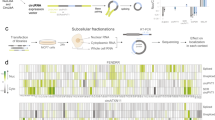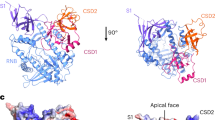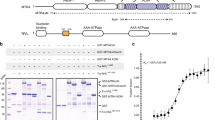Abstract
Alu-like elements comprise the most abundant family of interspersed repetitive sequences in primates and rodents1, and contain many features of processed genes2, suggesting that they were initially derived by reverse transcription of processed RNA transcripts. Transcripts containing Alu family members are represented in heterologous nuclear RNAs, cytoplasmic messenger RNAs and small RNAs1,3, although nothing is known about their function. Evolutionary studies4,5 strongly suggest that the parent RNA for the Alu-like elements is the highly conserved 7SL RNA, which is an essential component of signal recognition particle (SRP), a small cytoplasmic ribonucleoprotein whose function is the targeting of nascent secretory and membrane proteins to the rough endoplasmic reticulum (for a review see ref. 6). 7SL RNA is composed of both unique and Alu-like sequences7. SRP is rod-shaped8 and, in addition to its RNA, contains four proteins (two monomers composed of a polypeptide of relative molecular mass (Mr) 19,000 (19K) and one of 54K, and two heterodimers, one composed of a 9K and a 14K polypeptide, and the other composed of a 68K and a 72K polypeptide, respectively)9,10. The RNA moiety is required for SRP activity, as well as for structural integrity of the particle4. To investigate whether the Alu-like segments of 7SL RNA have a specific role in SRP activity, we have now purified and analysed a SRP subparticle that is created upon extensive digestion with micrococcal nuclease and entirely lacks the Alu-like sequences. We find that it contains the 72/68K, 54K and 19K proteins tightly bound, but lacks the 9/14K protein. In vitro activity assays demonstrated that the subparticle could still promote secretory protein translocation across the microsomal membrane, but could no longer trigger an arrest of pre-secretory protein synthesis. Re-addition of the 9/14K protein did not restore the elongation arrest. We conclude that the region of SRP comprised of the Alu-like RNA and the 9/14K protein exists in a distinct structural domain which is not required for the protein translocation promoted by SRP but apparently confers elongation-arresting activity on the particle.
This is a preview of subscription content, access via your institution
Access options
Subscribe to this journal
Receive 51 print issues and online access
$199.00 per year
only $3.90 per issue
Buy this article
- Purchase on Springer Link
- Instant access to full article PDF
Prices may be subject to local taxes which are calculated during checkout
Similar content being viewed by others
References
Schmid, C. W. & Jelinek, W. R. Science 216, 1065–1070 (1982).
Sharp, P. A. Nature 301, 471–472 (1983).
Calabretta, B., Robberson, D. L., Maizel, A. L. & Saunders, G. F. Proc. natn. Acad. Sci. U.S.A. 78, 6003–6007 (1981).
Walter, P. & Blobel, G. Nature 299, 691–698 (1982).
Ullu, E. & Tschudi, C. Nature 312, 171–172 (1984).
Walter, P., Gilmore, R. & Blobel, G. Cell 38, 5–8 (1984).
Ullu, E., Murphy, S. & Melli, M. Cell 29, 195–202 (1982).
Andrews, D. W., Walter, P. & Ottensmeyer, F. P. Proc. natn. Acad. Sci. U.S.A. 82, 785–789 (1985).
Walter, P. & Blobel, G. Proc. natn. Acad. Sci. U.S.A. 77, 7112–7116 (1980).
Walter, P. & Blobel, G. Cell 34, 525–533 (1983).
Gundelfinger, E. D., Krause, E., Melli, M. & Dobberstein, B. Nucleic Acids Res. 11, 7363–7373 (1983).
Walter, P. & Blobel, G. J. Cell Biol. 91, 557–561 (1981).
Siegel, V. & Walter, P. J. Cell Biol. 100, 1913–1921 (1985).
Sakonju, S., Bogenhagen, D. F. & Brown, D. D. Cell 19, 13–25 (1980).
Meyer, D. I. EMBO J. 4, 2031–2033 (1985).
Yamamoto, T. et al. Cell 39, 27–38 (1984).
Walter, P. & Blobel, G. Meth. Enzym. 96, 682–691 (1983).
Erickson, A. H. & Blobel, G. Meth. Enzym. 96, 38–50 (1983).
Walter, P. & Blobel, G. Meth. Enzym. 96, 84–93 (1983).
Gundelfinger, E. D., Carlo, M. D., Zopf, D. & Melli, M. EMBO J. 3, 2325–2332 (1984).
Zweib, C. Nucleic Acids Res. 13, 6105–6124 (1985).
Author information
Authors and Affiliations
Rights and permissions
About this article
Cite this article
Siegel, V., Walter, P. Removal of the Alu structural domain from signal recognition particle leaves its protein translocation activity intact. Nature 320, 81–84 (1986). https://doi.org/10.1038/320081a0
Received:
Accepted:
Issue Date:
DOI: https://doi.org/10.1038/320081a0
This article is cited by
-
Investigation of SRP9 protein expression in breast cancer
Molecular Biology Reports (2022)
-
Autoimmune Diseases and Polyamines
Clinical Reviews in Allergy & Immunology (2012)
-
Structure of the signal recognition particle interacting with the elongation-arrested ribosome
Nature (2004)
-
Structure and assembly of the Alu domain of the mammalian signal recognition particle
Nature (2000)
-
Characterization of the signal recognition particle (SRP) RNA population of tomato (Lycopersicon esculentum)
Plant Molecular Biology (1995)
Comments
By submitting a comment you agree to abide by our Terms and Community Guidelines. If you find something abusive or that does not comply with our terms or guidelines please flag it as inappropriate.



